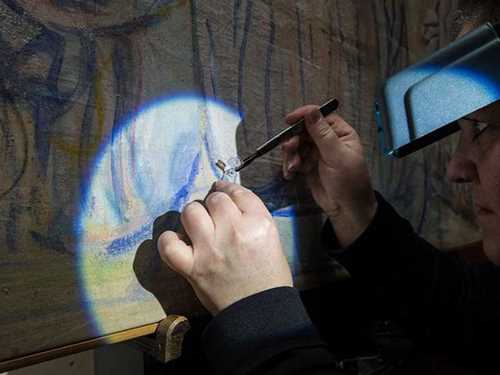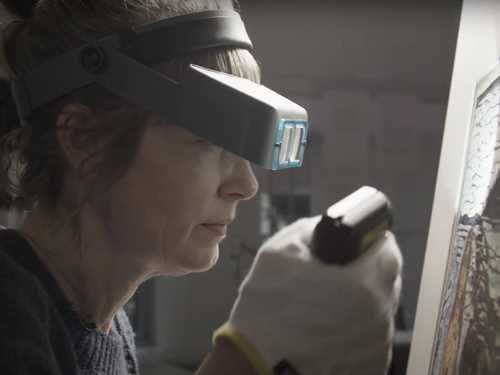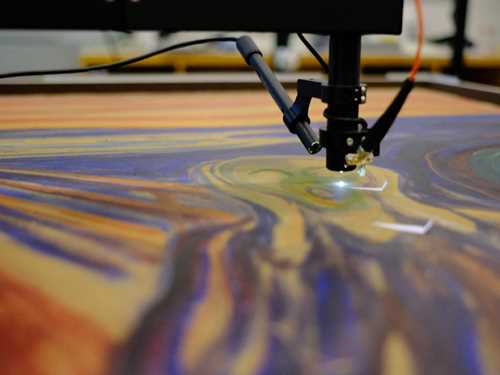Microfading: The balance between preservation and exposure
A quick method to evaluate the lightfastness of art.
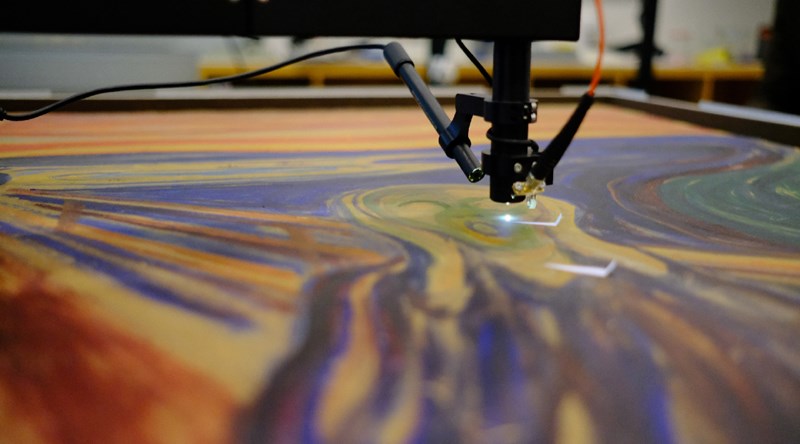
Microfading of The Scream. Photo: Tomasz Łojewski
One of the core functions of an art museum is to preserve the art for the future. This requires, among other things, insight into how exposure to light will affect the works chosen for exhibition.
One of the consequences of exposing the works to light is colour change, which is both undesirable and unavoidable. The sensitivity of an artwork to light is difficult to estimate, even if the materials and pigments are known. By increasing our knowledge about the light sensitivity of specific artworks at the Museum we can ensure that future generations will also be able to enjoy them.
Micro Fading Tester (MFT)
Microfading is an essentially non-destructive accelerated aging method that can be used to measure the light sensitivity of different materials, pigments and dyes. This is done by exposing a very small area (0.5 mm) to a high intensity beam of light and collecting the resulting data of the reflected spectrum. A microfading run is short - for our purposes a run of 6-10 minutes is sufficient to provide the data desired. By accelerating the light-aging of these very small areas we can simulate the effect of years of exposure to museum lighting, and the most sensitive colours or materials of each artwork can be identified.
The reflected spectrum of the colours, which provides information about the colour change, is collected in real-time. This means that one can choose to stop the test before the colour change reaches a level that is visible to the human eye. In most cases the area tested is so small that it cannot be seen, and therefore longer fading runs can be allowed.
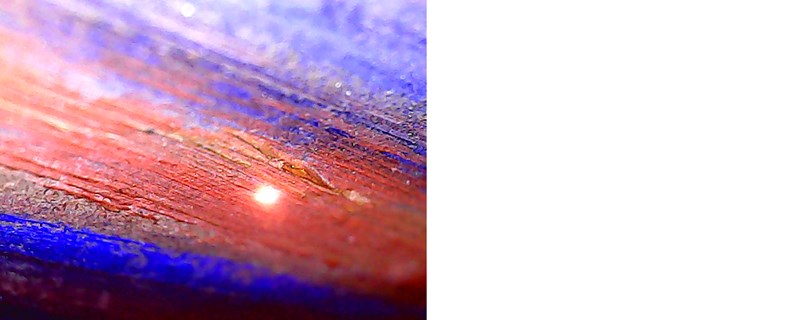
A point of measurement on The Scream (MM.M.00514). Detail from the motif/a bannister. Photo: Tomasz Łojewski
Microfading of works of art at the Munch Museum
Limiting damage caused by exposure to light is an important but difficult task for conservators as it is often their responsibility to decide on the recommended intensity of light and length of exposure. MUNCH in Bjørvika will have longer opening hours as well as more exhibition spaces. This means that more works will be exhibited simultaneously and for longer periods.
Because of the issues mentioned above, it has become necessary to review the Museum’s light policy for paper works. The current light policy considers the entire paper collection as a whole, and doesn’t take into account the light sensitivity of individual or groups of works. In recent years Microfading has become a useful tool for many museums facing similar preservation challenges. It was therefore decided to investigate if this method could be useful in the revision of the Museum’s light policy.
A weeklong workshop was held in September at the museum by dr. hab. Tomasz Łojewski from AGH University of Science and Technology in Poland. This workshop focused on testing works of art on paper that are planned to be exhibited in the opening exhibitions at the new Museum, in addition to all of the Museum’s versions of The Scream. A total of 229 points of measurement on 52 artworks were tested over six days.
Microfading results can be demonstrated as a colour change (DeltaE, ΔE) for a given cumulative exposure or light dose (megalux hours, MLxh) calculated from its spectral change over the test period according to a method defined by The International Commission of Illumination (CIE).
Based on the most light-sensitive area tested on each work of art the work is assigned a Blue Wool category. The Blue Wool (BW) Scale is a European standard (ISO 105-B08) that is used as a standard reference of lightfastness developed in the textile industry. The scale is defined from BW1 to BW8 where 1 is most sensitive to light and 8 is least sensitive to light (see light blue curves in figure belowe). Briefly, the theory can be explained that a very light sensitive dye or pigment will get a result equivalent to the BW 1 and might fade more rapidly. In cases where the result is closer to a BW 3, these colourants are 10 times more lightfast and consequently at lesser risk of colour changes.
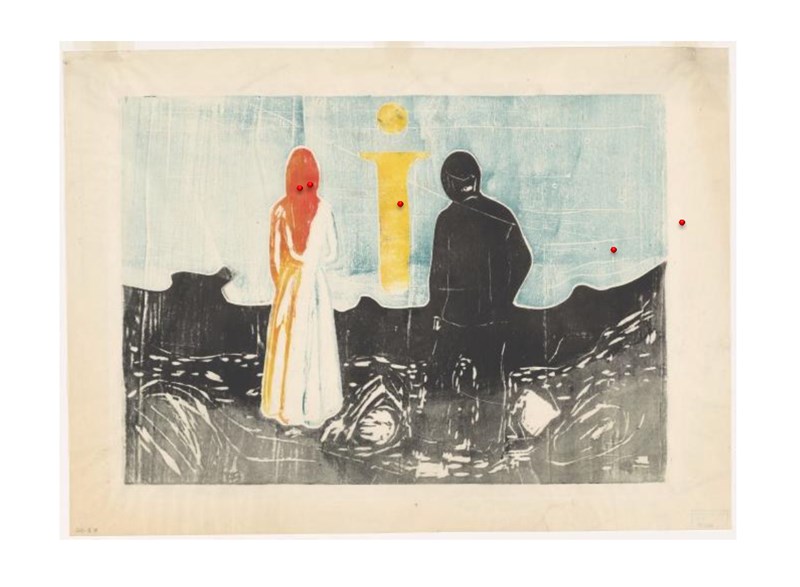
MM.G.00601-19 Two human beings. The lonely ones (1899). Colour woodcut. 5 points of measurement in red. Photo: ©Munchmuseet
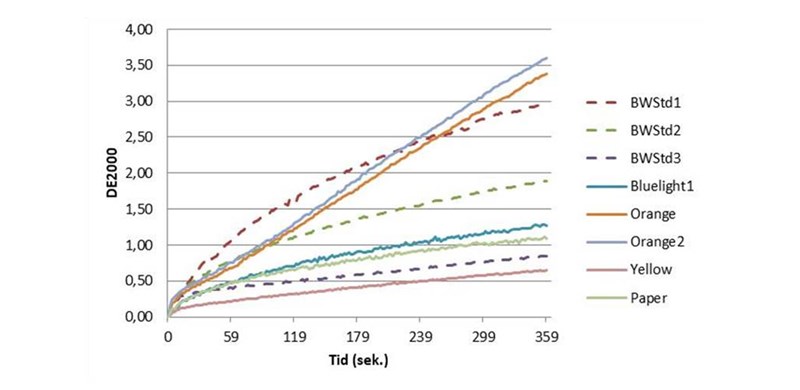
Figure 4. Microfading results from Two human beings. The lonely ones (MM.G.00601-19) in comparison to BW 1 – BW 3. The fading curve of the orange colours differs from the other curves.
Figure 4 illustrates the fading curves of 5 points of measurement taken from the coloured woodcut Two Human Beings. The Lonely Ones (MM.G.00601-19), in addition to the fading curves of BW 1 to BW 3. The curves illustrate the sensitivity to light of each material or colour in comparison to the closest BW curve. Based on the most sensitive material or colour, the whole work can be assigned a BW category. In some instances the shape of the curve deviates from the shape of the BW curves, meaning that the colour change might not gradually slow down as it is shown the case for the Blue Wools standards. This is exemplified in this version of Two Human Beings. The Lonely Ones. The measurements for paper and the blue and yellow colours follow the curvature of the BW scale. This means that the colour change is highest in the beginning, but then the curve flattens out, and colour change happens at a slower rate. The two points of measurement on an orange colour have a more linear curve than the BW scale curves, and a direct comparison is therefore difficult to make. This highlights the need to consider how the colours will change with future light exposure when assigning a work to a category of light sensitivity.
Deciding on a goal for preservation is key to forming a correct light policy. The results from the microfading tests must be assessed, and together with the preservation goals for the museum a “light-strategy” for a given work can be agreed. When more works are tested general recommendations for groups of works can be produced based on the results. This ensures that a balance between preservation and exhibition can be maintained.
